Pineapple-Gochujang Tempeh
Continuing the tempeh love with a crispy-fried, jammy-sweet-savory treatment. It comes together in less than 30 minutes, in just one pan.
Two quick things before I get to today’s recipe:
With St. Patrick’s Day coming up, I’ve opened last week’s Stout Bread with Barley Flour to all subscribers of this newsletter. It’s a really delicious and (pretty much) one-bowl operation, leavened with baking soda rather than yeast, which makes it quick as far as homemade bread goes. It’s one of my most favorite recent recipes.
Kate Ray recently shared a conversation we had in her newsletter Soft Leaves, which was a lot of fun. Among other things we discussed my recent obsession with dates, as well as (perfect segue for today’s recipe:) tempeh. I still haven’t got around to making my own tempeh but she has, and it looks amazing.
I’m committed to featuring more tempeh recipes, because of the many reasons it’s an incredible ingredient to keep in your rotation (very high in plant-based protein; great fiber and other nutrients; delicious, too). And as far as I can tell from my little pocket of the internet, it doesn’t get enough love.
Today’s recipe is fun, easy, and impossible not to like (at least I think so). Crispy-fried strips of tempeh, with their dense, satiating texture, are coated in a gently spicy, pineapple, honey, and gochujang-spiked sauce. Toasted cashews are sprinkled over at the end — these crunchy little rich bits somehow bring the whole thing together.
There are a couple other things going on, but not much. It comes together in one pan, and in less than 30 minutes, too.
And if you’re unfamiliar with tempeh, be sure to check out my quick primer from a few weeks ago:
What’s Gochujang?
Gochujang has been appearing in my recipes for a while, and it’s very likely you’re already familiar — but I often get questions, so here’s a quick rundown.
Gochujang is a Korean pantry staple, belonging to the family of fermented, soybean-based flavor pastes popular in several Asian cuisines (miso, doenjang, doubanjiang). It’s primarily made from dried chilies flakes as well as the soybeans, glutinous rice flour, salt, and usually some sweetener.
It’s thick and dense, and usually just a spoonful or two is all you need in a recipe. When I want some heat but also some easy depth of flavor, gochujang is often what I reach for. It has rich complexity thanks to the magic of fermentation.
I’ve long bought it at Korean grocery stores, but it’s increasingly available at Western supermarkets, too, sold in a tub, pouch, or jar. And you can always order it online. But a few years ago I found that East Branch Farms, at the Union Square Farmers Market here in New York, sells small-batch, handmade gochujang and it’s pretty wonderful. It may be worth doing a little digging to see what’s available where you live.
Just make sure to buy the paste, not gochujang sauce. (With the paste, you can make your own sauce.) It keeps for quite some time, but once you have it on hand, you’ll probably start adding a little spoonful to everything — marinades, dressings, dips, sauces, even as a condiment for a sandwich. That’s what I do.
Recipe Video
Pineapple-Gochujang Tempeh
You could certainly make this with tofu instead of tempeh, but I think the tempeh is special here.
I love pineapple juice and usually have cans of it in my cupboard (the Trader Joe’s kind is great!). I haven’t tested this, but imagine that swapping apple juice would work fine.
See above if you have any questions about gochujang. Doenjang is similar to miso paste, essentially the Korean version, but made from only soybeans and salt (miso uses a koji starter as well, and typically other grains); doenjang is more dense and dry, less sweet, and saltier. There’s only a small amount in here and you can substitute miso paste instead, but if you do you may want to season with a little more salt.
Yield 2 to 3 servings | Prep & cook time 30 minutes
About 3 tablespoons avocado or olive oil, divided
One 8-ounce package tempeh, cut into ¼-inch thick rectangles
½ medium white or yellow onion, diced
3 cloves garlic, sliced
Fine sea salt
1 ½ tablespoons honey
1 heaping tablespoon gochujang
1 teaspoon doenjang (or miso paste)
½ cup pineapple juice
¼ cup toasted cashews, coarsely chopped
Freshly cooked rice or other grain, for serving
1. Set a medium skillet over medium heat and once hot, swirl in about 2 tablespoons oil. Add the tempeh, arranging it in an even layer, and fry until beautifully golden-brown on the bottoms, 3 to 5 minutes. Flip and repeat on the opposite sides. Transfer the tempeh to a plate.
2. Return the skillet to the heat and add about 1 tablespoon more oil, followed by the onion, garlic, and a few pinches of salt. Cook until the onion is soft and beginning to brown, 6 to 8 minutes, lowering the heat if necessary to prevent burning. Meanwhile, whisk together the honey, gochujang, doenjang, and a few splashes of the pineapple juice in a measuring glass or bowl until smooth, then whisk in the rest of the pineapple juice.
3. Once the onions are soft and beginning to brown, pour in the pineapple-gochujang mixture. Adjust the heat to achieve a gentle simmer, and cook, stirring periodically, until it reduces and thickens enough that you can trace a thick line in the pan using a spoon or spatula, 7 to 10 minutes. Return the tempeh to the pan and stir gently to coat it in the sauce and reheat. Sprinkle with the cashews and serve hot, over your favorite cooked grains.








thank you so much for both of these recipes, lukas. i''m really excited to make/bake both of them.
the best tempeh can be found from a boston small company: BOStempeh.com. i order a bunch online and keep the packages in my freezer. i love it. heading over to defrost some right now.
made it today, lukas. loved the way the pineapple juice carried the thicker pastes. next time i thought i might saute some small pineapple cubes before adding the sauce to bring more pineapple flavor to the dish. really loved it. thanks again.